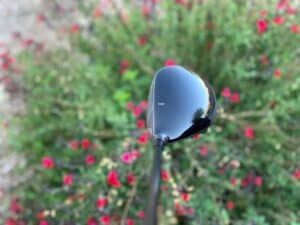- Updated: December 19, 2023
5 Wood vs. 7 Wood
The main difference between the 5 Wood and the 7 Wood golf club is distance.
The average male golfer will hit their 5 wood 200-220 yards, and their 7 wood 180-200 yards.
The 5 Wood is a slightly longer club that will hit lower and longer shots compared to the 7 wood.
Previously thought of as clubs designed for high handicappers and the slower swing speed player, the 5 Wood and 7 Wood are beginning to gain an appropriate reputation as a versatile club option for every type of golfer.

Players of all skill levels love that these fairway woods operate as an easier to hit alternative to long irons with a significant yardage advantage, have more stopping power, and land softly compared to many golfer’s long irons, and the fact that these clubs can be used for tee shots as well as long distance approaches.
Our breakdown below will define the benefits of both the 5 Wood and 7 Wood to help golfers struggling to decide which club will benefit their game and scores the most. Who knows, after hearing how great both clubs are, readers might choose both!
Overview of the 5 Wood vs. 7 Wood
The loft angle, head shape, and overall ease of use for different players are the primary physical differences between the 5 Wood and 7 Wood.
The clubs are most certainly in the same “fairway wood category” and look nearly identical, but each club has some advantages over the other depending on what you’re looking for as a golfer.
Here are the most significant reasons to carry a 5 Wood and/or a 7 Wood.
Pros of a 5 Wood
Better Asset Off the Tee Box
Yardage Advantage Due to Less Loft
Versatile in Distance
Pros of a 7 Wood
Shorter Shaft Length Can Mean Slightly Easier to Hit with More Control
More Control Equals More Precision
More Loft for Greater Stopping Power
Arguably Better Out of Rough (Depending on Head Shape and Design)
Below we expand on each key feature of either fairway wood option as well as a few more identifying differences between the two clubs.
Overview of the 5 Wood
Better Asset Off Tee Boxes
Golfers that are struggling to use their driver, 3 wood, or driving and longer irons for tee shots find a ton of utility in a 5 wood. Here’s why:
When directly comparing the 5 Wood and 7 Wood, the 5 Wood will usually have between 18-21 degrees of loft while a 7 Wood generally has 21-24 degrees of loft.
This difference in loft angle, even though it’s only a few degrees, allows a 5 Wood to have a much more penetrating trajectory than a 7 Wood. This will enable players to experience more roll once it hits the fairway, more carry distance, and total distance overall.
For those tight fairway shots required on tricky Par 4’s, a 5 Wood is usually going to be a better option than a 7 wood.
Yardage Advantage Due to Less Loft
As we already determined, a 5 Wood will have a yardage advantage over a 7 Wood.
Think about the 3 Wood as a step down from the driver. Following that logic, a 5 Wood is a step down from a 3 Wood, and a 7 Wood is a step down from a 5 Wood. Not necessarily in utility and playability, just distance.
This makes the 5 Wood a viable asset off tee boxes (since golfers will be closer to the hole) and gives it a distance advantage on longer approach shots over a 7 Wood.
Versatile in Distance
A 5 Wood has much more variability and versatility in distance than a 7 Wood. Besides its lower loft angle, a 5 Wood usually has a shaft at least a half inch longer than a 7 Wood, making it easier to swing with a faster club head speed and swing speed.
Low handicap players and faster swing speed golfers will be able to hit a 5 Wood low with less spin for distance comparable to 3 Wood, and hit higher, more spinny shots to tune the 5 Woods yardage down to a 4 irons distance if needed.
As an example of the variable yardage capabilities of a 5 Wood, attached above is a video of Collin Morikawa hitting his 5 Wood at different trajectories and spin rates to reach a green at distances anywhere from 250 yards to 300 yards!
Overview of the 7 Wood
Shorter Shaft Length Equals Easier to Hit
As we mentioned, a 7 Wood usually always has a shorter shaft length than a 5 Wood. This half-inch shorter shaft makes the 7 Wood slightly easier to hit while reliably finding the center of the face.
By being able to hit the center of these fairway wood faces more often and reliably, some golfers find greater consistency in striking with a 7 Wood compared to a 5 Wood.
Greater Levels of Precision
Being slightly shorter in length and a bit easier to hit than 5 Woods for some golfers, players seeking increased precision and accuracy on longer approach shots into greens have great success with a 7 Wood.
Having additional loft (compared to a 5 Wood) and greater spin per shot increases a player’s likelihood of finding fairways with this club as well as their ability to work the ball in different directions for greater shot-making capability.

More Loft Equals Greater Stopping Power
There aren’t many worse feelings than hitting a long shot right toward the flag, but the ball doesn’t have enough height or spin to hold the green once it makes contact with the putting surface.
7 Woods (having an average loft angle between 21-24 degrees) have a steeper ascent to their peak apex, have a higher peak apex than 5 Woods, and have a more vertical angle of descent into greens, meaning their stopping power is fantastic.
While they won’t often hit a fairway and roll for long distances (making them worse off tee boxes), they will stick to greens and give players more Birdie and Eagle chances.
Arguably Better Out of the Rough and Tricky Lies
If you don’t find the center of many fairways but want more distance from those “rough” positions (Get it?) than a standard Hybrid or Rescue Club, a 7 Wood might be a fantastic tool to add to your golf bag.
On top of 7 Woods being slightly shorter, and some players report easier to hit than longer fairway woods, 7 Woods will often have larger and more forgiving sole designs and head shapes that will make them easier to use in thicker rough and tricker lies.
7 Woods head shapes can be thinner in overall width than a 5 Wood (more resembling a hybrid’s thickness than fairway wood) which gives many golfers an increased sense of confidence that they are going to get the ball higher out of the rough than long irons or harder to hit lower lofted fairway woods.
What Type of Golfer Will Have Success with a 5 Wood?
Golfers looking to bridge the yardage gap between their long irons and 3 wood or driver while still wanting a valuable weapon off the tee will love the addition of a 5 Wood to their bags.
Slower swing speed golfers will love the distance advantages over the 7 Wood, and faster swinging players will appreciate the ability to hit lower ball flight “punch style” shots as well as longer shots for longer approaches and off tees.
If your primary concern with either of these clubs is to hold more greens only, the higher-lofted 7 Wood is likely a better choice. If you’re looking for a tuned-down, easier to control version of your 3 Wood, a 5 Wood is a great bet.
PGA Tour Pros That Use a 5 Wood:
Justin Thomas, Bryson DeChambeau, Xander Schauffele, Jon Rahm
What Type of Golfer Will Have Success with a 7 Wood?
Golfers looking to replace some of their more challenging-to-hit long irons or players who can’t achieve the needed height and spin to hold greens with their current long approach clubs will adore the addition of a 7 Wood.
Slower swing speed players will have an easier time getting a 7 Wood airborne and moving straight than a 5 Wood (the lower the loft, the more difficult a club is to get airborne).
Fast swinging players will also love a 7 Wood because of how easy they are to hit solidly and work in either direction. Players confident in their shot-making ability and those who like to add spin to the ball will love the 7 Wood.

7 Woods and Hybrids operate very similarly to one another, with a 7 Wood usually having more distance and less height and spin. If you’re looking to replace your hybrid for something a bit longer, a 7 Wood is the right club for the job.
PGA Tour Pros That Use a 7 Wood:
Dustin Johnson, Cameron Smith, Max Homa, Stewart Cink
Final Verdict
Buying one of these more “specialty clubs” right off the rack and expecting it to work perfectly for the yardage gap and shots you have in mind is truly ridiculous.
As we’re known to say often, we encourage every golfer reading this article to TEST THESE CLUBS FOR YOURSELF at a professional facility to find what will work the best for your game and particular circumstances you’re hoping to get better at through the purchase of one of these clubs.
For low handicappers and faster swinging golfers, we say choose whichever club gives you the most reliable feeling and carry distances to achieve whatever you’re after.
Higher to mid handicappers and slower swingers of the golf club will love how easy 7 Woods are to hit higher and consistently at that.
If you’re the type of golfer that doesn’t like to hit hybrids or long irons, you could easily implement both of these clubs into your bag for the ultimate ease and playability from these longer distances.
About The Author
Writers of Independent Golf Reviews
Independent Golf Reviews has tested and reviewed 1000+ golf products over the past 10 years. We use our experience and expertise to give golfers an unbiased insight on the market.
Read more…
Share
Receive the best golf discounts available exclusively for our subscribers and be auto entered into our monthly golf giveaways!
Success!⛳️
You are now an official member of IGR. Keep an eye out for the perks.
No spam, ever. 🔒

